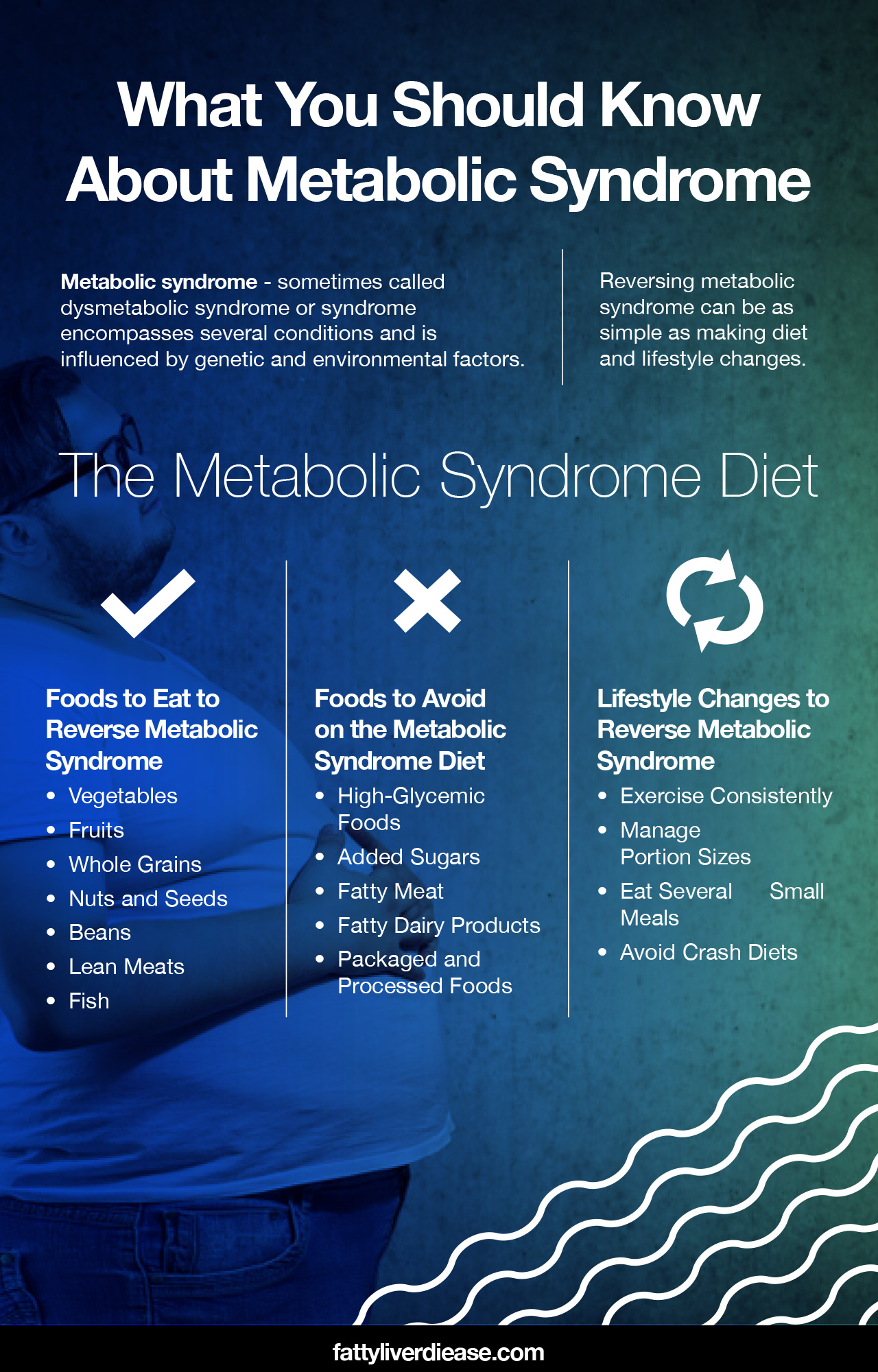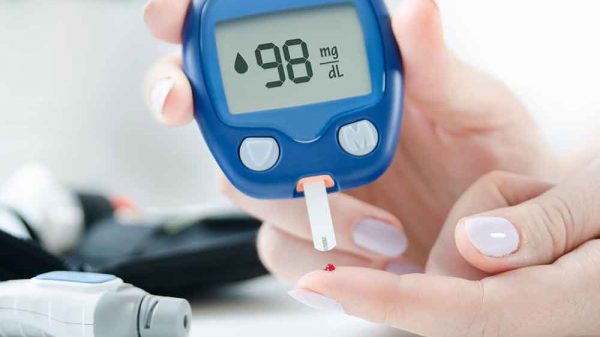Metabolic syndrome affects millions of Americans and includes multiple conditions like diabetes and insulin resistance. The metabolic syndrome diet can help you reverse metabolic conditions while also improving your health, wellness, and quality of life.
In many cases, reversing metabolic syndrome can be as simple as making diet and lifestyle changes. Read on to find out what you need to know about metabolic syndrome and reversing metabolic conditions with diet and lifestyle changes.
What You Should Know About Metabolic Syndrome
Before we get into the diet and lifestyle changes needed to manage metabolic syndrome, let’s first talk about what it means to have metabolic syndrome.
Metabolic syndrome – sometimes called dysmetabolic syndrome or syndrome X – encompasses several conditions. Physicians use a set of specific diagnostic criteria in order to diagnose metabolic syndrome: (1)
- High blood pressure: High blood pressure, or hypertension, occurs when your blood exerts too much pressure onto blood vessel walls. Doctors will look for a blood pressure of 135/85 millimeters of mercury (mm HG) or above. The first number describes systolic blood pressure, which is the pressure on blood vessel walls as the heart pushes oxygenated blood throughout the body. The bottom number is diastolic blood pressure and describes pressure as blood travels back towards the heart.
- High blood triglycerides: Triglycerides are a type of fat or lipids in the bloodstream. Though having some triglycerides in the bloodstream is normal, a level above 150 milligrams per deciliter (mg/dL) is considered too high.
- High blood sugar: If you have high blood sugar, your blood glucose levels are too high. A fasting glucose level above 100 mg/dL is described as high.
- Obesity: Being overweight is one of the diagnostic criteria for metabolic syndrome. Physicians often consider waist circumference as an indicator for obesity, since abdominal obesity is particularly detrimental for metabolic and cardiac function. Doctors look for a waist circumference larger than 35 inches in females and 40 inches in males.
- Low HDL cholesterol: High-density lipoprotein, or HDL cholesterol, is a good kind of cholesterol that helps the metabolism operate as it should. HDL cholesterol levels below 40 mg/dL are too low for men, and levels below 50 mg/dL are too low for women.
When an individual is diagnosed with at least three of these conditions, the individual is at significant risk of developing more serious diseases, like:
- Type 2 diabetes: Type 2 diabetes is a condition that is more likely to develop from a diet that is consistently high in blood sugar. When we eat too much sugar, glucose rapidly enters the bloodstream, and blood sugar levels spike. The pancreas then releases a hormone called insulin that is responsible for signaling to cells to utilize the sugar as energy. Over time, chronic sugar intake can cause insulin to work less efficiently, causing a condition called insulin resistance. Cells do not react to the presence of insulin, and therefore do not utilize glucose in the bloodstream.
- Heart disease: Over time, chronically high levels of low-density lipoprotein cholesterol (the bad kind) and triglycerides, coupled with low HDL cholesterol and high blood pressure, can significantly increase your risk of developing cardiovascular disease. High LDL and triglyceride levels contribute to atherosclerosis, which is the development of plaques on arterial walls. These plaques can eventually impede blood flow, cutting off oxygen and nutrients to vital organs. They can also break away from the arterial wall and travel to other areas of the body, increasing the risk of heart attack and stroke.
Who develops metabolic syndrome? The risk factors for developing metabolic syndrome are a mix of genetic and environmental influences. Having a family history of metabolic abnormalities may mean that you have a genetic predisposition to developing metabolic syndrome. A diet high in saturated fat and sugar, as well as a sedentary lifestyle, can both contribute to the development of metabolic syndrome as well.
Metabolic syndrome is also connected with other metabolic and hormonal conditions like fatty liver disease and polycystic ovary syndrome (PCOS).
Symptoms of Metabolic Syndrome
Metabolic syndrome rarely has clear symptoms. Weight gain, especially in the abdominal area, is a sign that your metabolism may not be working as it should. However, the chances of observing extremely high triglycerides symptoms, high blood pressure, or high cholesterol are very low.
The best way to look out for metabolic syndrome is to stay up-to-date with your routine check-ups. During check-ups, your physician will check your weight and blood pressure. You will also receive blood work that checks your cholesterol, triglyceride levels, and blood sugar levels.
How to Follow the Metabolic Syndrome Diet
Here we go through everything you need to know about foods to eat and foods to avoid on the metabolic syndrome diet.
Foods to Eat to Reverse Metabolic Syndrome
1. Vegetables
Eating your veggies is not only important through childhood but also in adulthood. Incorporating plenty of vegetables into your meals boosts your intake of vitamins, minerals, antioxidants, and fiber. All of these components of vegetables help lower inflammation, support healthy metabolic function, and reduce oxidative stress in the body.
Plus, eating plenty of vegetables can be an effective strategy for encouraging weight loss. Vegetables are large in volume and nutrient-dense, without being energy-dense. As a result, you can fill up your stomach and feel satisfied, without consuming too much food. Eating plenty of veggies with every meal can help curb your appetite and maintain a healthy caloric intake for your needs.
Certain vegetables can even help you achieve lower blood pressure levels. Veggies like beets, arugula, celery, and spinach contain natural nitrates. These compounds help improve the function of the endothelium, which is a very thin layer of cells that line blood vessels and control dilation and constriction. Increased intake of natural nitrates increases blood flow, helps blood vessels dilate, and lowers your blood pressure.
2. Fruits
Fruit is a nutrient-packed part of a healthy diet for metabolic syndrome. Vibrantly colored fruits contain an array of antioxidants like polyphenols that neutralize free radicals and reduce oxidative stress. If you have a sweet tooth, fruits provide a delicious and healthy substitute for sweet snacks or after-dinner treats. Enjoy fruits like blackberries, strawberries, mangoes, blueberries, apples, and oranges.
In some cases, it may be necessary to limit your fruit intake or to ensure that you consume fruits with a low or medium glycemic index. Always listen to medical advice and guidance from a registered dietitian.
3. Whole Grains
Carbs are not the enemy of a healthy metabolism; only simple carbs are. In contrast, whole grains are complex carbs that have not been subjected to an industrial process and are instead left intact with the hull. The hull or the outer layer of whole grains is darker in color and rich in nutrients, fiber, and protein. Whole grains are processed slowly in the digestive system because of the high content of fiber and protein. As a result, eating whole grains prevents blood sugar spikes. Reach for grains like quinoa, brown rice, whole-grain bread, millet, buckwheat, and oats as part of a healthy diet that reverses metabolic syndrome.
4. Nuts and Seeds
Nuts and seeds are packed with healthy fats, antioxidants, and fiber. Consuming nuts and seeds regularly helps lower inflammation, supports healthy blood pressure levels, and keeps your digestive system running smoothly.
Sometimes it can be tricky to figure out how to incorporate nuts and seeds into your diet. So, how can you eat more nuts and seeds? Here are a few ideas:
- Sprinkling pumpkin seeds on a salad
- Topping your oatmeal with crushed almonds or walnuts
- Adding ground flaxseeds or chia seeds to your smoothies and oatmeal
5. Beans
Beans are an excellent source of fiber, protein, and minerals. The rich fiber content of beans helps improve digestive health, which can in turn influence metabolic health. When we eat fiber-rich foods, we are supporting the growth of healthy bacteria in the gut. Good bacteria in the digestive system feed on the fiber we eat and produce anti-inflammatory compounds as byproducts. These compounds then travel to other areas of the body via the bloodstream. A healthy and flourishing microbiome helps lower inflammation throughout the body, promoting improved metabolic function.
How can you incorporate more beans into your diet? Try these ideas:
- Top your salads with chickpeas
- Use black bean and kidney beans as meat substitutes in soups and stews
- Prepare hummus dip with chickpeas
- Try bean spreads as a condiment on sandwiches
- Enjoy curried lentils over brown rice
6. Lean Meats
Lean meats are rich sources of protein that offer essential amino acids that your body requires. Amino acids are the smallest units of protein that are crucial for human health. In particular, the body requires optimal ratios of essential amino acids to produce muscle tissue, hormones, neurotransmitters, and enzymes. Muscle tissues, hormones, and enzymes especially play critical roles in metabolic function.
Moreover, consuming a diet rich in protein helps you feel fuller for longer because it digests more slowly. Choose lean meats like chicken breast and turkey breast.
7. Fish
Fish is an excellent source of both essential amino acids and omega-3 fatty acids. Omega-3 fatty acids are polyunsaturated fats that are revered for their anti-inflammatory properties. Regularly consuming omega-3 fatty acids is healthy for all organ systems, like the brain, liver, and metabolism.
Keep in mind that not every kind of fish is high in omega-3 fatty acids. Mackerel, salmon, and sardines are some of the richest sources of healthy fats. If you are vegetarian, you can also get omega-3 fatty acids in the form of alpha-linolenic acid (ALA) from foods like flaxseeds, chia seeds, pecans, and walnuts.
Monounsaturated fats are also healthy and should be regularly incorporated into your metabolism-friendly diet. Great sources of monounsaturated fats include nuts, seeds, avocados, and olive oil.
Foods to Avoid on the Metabolic Syndrome Diet
1. High-Glycemic Foods
Not all carbohydrates are bad for metabolic syndrome. Only high-glycemic foods are detrimental to metabolic syndrome. High-glycemic foods are those that the body rapidly converts into sugar. When the body is able to quickly break down carbohydrates into sugar, blood sugar levels spike and the body is under pressure to utilize the sugar in the bloodstream. Chronic consumption of high-glycemic foods contributes to insulin resistance and diabetes. Examples of high-glycemic foods are soda, candy, white pasta, white bread, white rice, pastries, and sweets. White potato also has a high glycemic index.
2. Added Sugars
Avoiding added sugars helps keep your sugar intake low. Added sugars have been removed from their original source, processed, and added into packaged products to make them sweeter or improve taste and texture. However, these added sugars are quickly processed by the body and converted to glucose, contributing to weight gain, high blood sugar, insulin resistance, type 2 diabetes, fatty liver disease, and other metabolic abnormalities.
Added sugars are hidden in so many foods, even foods you may think of as savory. Of course, it’s important to avoid all of the overtly sugary foods, such as pastries, cookies, cakes, candy, and soft drinks. However, keep in mind that sugar may also be lurking in products like breakfast cereal,
3. Fatty Meat
Fatty meat is one of the significant contributing factors to metabolic syndrome. Fatty meat products contain lots of saturated fat, which disrupts the function of insulin. Plus, a high saturated fat intake over time contributes to high triglycerides and high LDL cholesterol. As a result, there is a direct connection between saturated fat intake and the risk of heart disease. In order to support a smoothly functioning metabolism and a healthy heart, cut back on your intake of fatty meat products. Here are a few examples of foods to avoid:
- Fatty cuts of steak and ground beef
- Bacon
- Cured meats
- Pork
- Dark meat from chicken and turkey
4. Fatty Dairy Products
Like fatty meats, fatty dairy products are high in saturated fat that clogs arteries and impedes healthy insulin function. When choosing dairy products, it’s always important to look for low-fat and nonfat options. Examples of dairy products to avoid include:
- Whole milk
- Butter
- Hard cheeses, which are typically fattier than soft cheese
- Yogurts made with whole milk
- Cream
5. Packaged and Processed Foods
Though convenient and tasty, packaged and processed foods are packed with tons of ingredients that are bad for metabolic health. Packaged foods tend to be high in sodium, saturated fat, added sugars, and trans fats.
Trans fats and saturated fats have a similar impact on the body. Both worsen inflammation and contribute to high triglycerides and heart disease. Added sugars impair normal insulin function and contribute to weight gain.
Eating too much salt can cause high blood pressure, while also contributing to systemic inflammation. The American Heart Association recommends that adults should keep sodium intake at or below 1500 milligrams (mg) per day. (2)
What kinds of foods should you stay away from? Here are a few examples:
- Chips
- Cookies
- Frozen meals
- Cured meats
- Candy
- Breakfast cereal
- Cheese
- Pastries
Lifestyle Changes to Reverse Metabolic Syndrome
In addition to a healthy diet, adapting your lifestyle can also make a huge difference.
1. Exercise Consistently
Regular physical activity is one of the most important steps you can take to protect your health and reverse metabolic syndrome. Both aerobic exercise and strength training have beneficial effects on the body.
Aerobic exercise or cardio gets your heart rate up and is particularly beneficial for cardiac health. Engaging in regular aerobic exercise supports a strong heart and helps lower your blood pressure.
Strength training helps build muscle. By challenging your muscles, you are inflicting tiny tears in muscle fibers that must heal, which promotes stronger muscles. Having a higher percentage of lean body mass increases your resting metabolic rate, helping your body burn energy and fat tissue faster.
Both aerobic exercise and strength training promote weight loss by increasing the number of calories you burn and can help you get rid of abdominal fat. Regular exercise is linked to improved insulin function, better blood pressure, improved cardiac health, and a healthier body mass index (BMI).
2. Manage Portion Sizes
Eating smaller portions is an important strategy for reaching a healthy weight and reversing metabolic syndrome. You can keep your portion sizes smaller by using these tips:
- Put less food on your plate. When you serve your plate of food, give yourself smaller portions than usual. This gives you the option to get seconds if you’re still hungry, or to stop eating if you’re full. Putting less food on your plate eliminates the pressure to clear your plate.
- Eat mindfully. When you are eating a meal, enjoy each bite. Chew slowly and savor the flavors. Eating mindfully increases the likelihood that you’ll stop eating when you feel full while reducing the chance of overeating.
- Eat at the table. We all get used to eating while standing in the kitchen, watching TV, or while driving to the next activity. When possible, sit at the table to eat your meals, so you can eat slowly and mindfully.
3. Eat Several Small Meals
Instead of three large meals, try eating five or six small meals throughout the day. Eating more frequently staves off hunger pains and helps prevent overeating during the next meal. Plus, eating healthy meals more frequently helps keep your blood sugar stabilized throughout the day.
4. Avoid Crash Diets
Crash diets can cause more harm than good when it comes to protecting your metabolic health. Most crash diets and fad diets are extremely restrictive, cut out food groups, and lead to nutrient deficiencies. Plus, they usually backfire. Food and nutrient deprivation can trigger binge eating, causing you to regain much of the weight you might’ve initially lost.
If you want to follow a specific diet plan for managing metabolic syndrome, stick to a balanced diet plan like the Mediterranean diet, paleo diet, or insulin resistance diet menus.
Things to Keep in Mind
It’s important to make sure that you discuss all diet and lifestyle changes with your physician. A registered dietitian or nutritionist is an excellent resource as well, for ensuring that all of your diet changes support your health needs. Your doctor may also prescribe medications like statins or metformin to help normalize cholesterol levels and improve insulin sensitivity.
Conclusion: Metabolic Syndrome Diet
Metabolic syndrome has a high prevalence in the United States and is influenced by genetic and environmental factors. Dietary changes and lifestyle changes play a central role in reversing metabolic syndrome and associated conditions. Eating primarily whole foods, watching your calorie intake, and exercising regularly are effective strategies for reversing metabolic syndrome and improving your quality of life.

References:
(1) https://www.mayoclinic.org/diseases-conditions/metabolic-syndrome/diagnosis-treatment/drc-20351921























